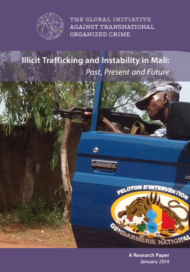Posted on 06 Apr 2014
The authors would like to thank Ms. Kavanagh and Dr. Ellis for their thoughtful, 4,000 word commentary on the Global Initiative report Organized Crime and Illicit Trafficking and Instability in Mali: Past, Present and Future.
Much of the commentary offers additional information which is useful to consider, but may or may not be relevant to the topics of organized crime and illicit trafficking as they pertain to instability in Mali.
On a few occasions, the commentary provided by Ms. Kavanagh and Dr. Ellis does grapple with specific claims or conclusions made by the authors of the report in question. Please see the authors’ responses below.
The Not-So-Hidden Crisis
Ms. Kavanagh and Dr. Ellis take issue with the report’s characterization of the extent to which analysts failed to adequately diagnose the health of Mali’s democracy before it collapsed. In doing so, they highlight a few sources that touched upon specific weaknesses in Mali’s democracy before the crisis. All of the works the authors cite are rigorously researched and do highlight some of the weaknesses and imperfections of Mali’s fledgling democracy, but they by no means constitute a sounding of the alarm (in fact, at least one of the works cited as such is positive, overall, about the prospects of Malian democracy).
The broader point of the section titled “Mali’s (Hidden) Crisis,” which perhaps could have been better named, is that the international community’s response to the crisis was woefully inadequate. It is the belief of the authors of the Global Initiative report that this failure to respond was due in large part to a lack of understanding the depth and breadth of the crisis in the first place.
At some point, the debate over who said what, when and how stridently is a matter of semantics. Whether or not there were indeed voices within academia, the donor and development communities, or international organizations warning that Mali’s democracy was on the brink (and the authors of the Global Initiative would welcome links to these accounts), none of these concerns led to meaningful shifts in policy or approaches by the international community toward Mali in the run-up to the crisis.
Choose Your Crime
Ms. Kavanagh and Dr. Ellis write:
The paper places significant emphasis on cocaine, noting that cocaine and other narcotics continue to flow through the north of Mali despite the presence of Operation Serval and MINUSMA troops. Yet it is bold to draw hard conclusions on this matter, as the data on these flows remain unreliable. It would be important to build on the interviews conducted for the purpose of this paper, including in producing and consumer countries, in order to ascertain the degree to which cocaine is still being routed through Northern Mali or whether traffickers have rerouted through other less risky (and therefore less expensive) places, as some other studies have suggested.
The admittedly bold claim that cocaine and other narcotics continue to flow through the north of Mali despite the presence of Operation Serval and MINUSMA was widely relayed to the authors of the report by government officials in northern Mali, interlocutors – both national and international, including those involved in security and law enforcement operations in the region – and alleged traffickers in key trafficking hubs. The authors of the report will concede that more data on these flows would be useful, but in lieu of such data ever existing or being reliable, the authors stand by the qualitative approach to assessing the impact of Operation and Serval on the flow of narcotics through northern Mali.
The authors of the report agree with Ms. Kavanagh and Dr. Ellis that it is important to build on the interviews conducted for the purpose of this paper.
The authors of this paper do not consider the unattributed link to a 350 word article on the Sky News website as evidence of a study suggesting traffickers have rerouted through other less risky places, but we would be eager to read any studies that do.
Ms. Kavanagh and Dr. Ellis write:
The authors of the Global Initiative paper also suggest that the flow of narcotics through Bamako is rather unimportant. However, while the issue is not yet highly salient, interviews in Bamako suggest a growing availability and consumption of amphetamine-type substances (ATS) and crack cocaine, reflecting the general problem of transit countries eventually becoming consuming countries. Interviews with detainees suggest that Bamako airport is still viewed as an easy point of transit for both amphetamines and cocaine en route to Asia or Europe. Meanwhile, the paper confirms that Kayes is a point of transit for narcotics transported from Guinea, and that it is becoming an important trafficking hub for the region as a whole.
The authors of the Global Initiative paper do not, in fact, suggest that the flow of narcotics though Bamako is rather unimportant. Rather, the authors highlight that a small percentage of what is trafficked through Mali passes through Bamako, and reiterate the widely held conclusion that the dynamics of trafficking in northern Mali were a key driver of instability in northern Mali. The authors of the Global Initiative agree that Bamako airport is still viewed as an easy point of transit for narcotics en route to Asia or Europe.
Ms. Kavanagh and Dr. Ellis write:
Narcotics and arms trafficking have certainly proved lucrative in Mali, providing important incentives to a range of actors, particularly in the north, but these are not the only forms of illicit activity that pose a threat to the country’s stability. Kidnapping for ransom has become a highly lucrative activity nurturing relations between insurgent or bandit groups in the north of Mali and throughout the region, on the one hand, and the Malian state on the other hand. By devoting their main attention to illicit trafficking, the authors of the Global Initiative paper perhaps accord to the ransom industry less importance than it merits in a study of politics and organized crime. For Lacher, this illicit industry, which emerged in the 1990s as a form of ‘residual banditry,’ is perhaps the most lucrative and potentially most damaging from a security and developmental perspective (Lacher, 2012). For example, Lacher notes that, from 2008 until the publication of his paper on organized crime and conflict in the Sahel-Sahara region, the income derived from kidnapping is likely to have totalled between US$40 million and US$65 million, ‘paid mostly by Western governments.’ The high incidence of hostage-taking, he adds, also caused the collapse of the tourist industry in the Sahel and the Sahara, ‘further limiting opportunities for employment and profit outside of criminal activity’ (Lacher, 2012).The kidnapping and subsequent killing of two French radio journalists in 2013, and the kidnapping of Malian Red Cross personnel in February 2014, suggest that this situation will prevail for some time.
The authors of the Global Initiative paper suggest that illicit trafficking has hollowed out Mali’s institutions. Yet Mali’s government had been eroded or hollowed out long before the rise of narcotics trafficking in the first decade of the present century. For example, public sector corruption has been the basis for Mali’s illicit economy for decades and provides a core challenge to governance and democratic development. Yet, the authors’ strong focus on the relatively new phenomenon of narcotics trafficking causes them to devote rather little attention to corruption, a structural part of Malian political life. Exact figures, needless to say, are hard to find, but perusal of the US State Department Human Rights Reports spanning the period 2005-2011 paints a daunting picture of corruption in Mali. In that period, reports from the Office of the Attorney General suggest that some US$ 740 million in public funds (much of it aid money) were lost to fiscal mismanagement, corruption, fraud, tax evasion and theft in core ministries, agencies and official programmes. Such abuse was particularly evident in ministries with a responsibility to deliver services to Mali’s population (one of the poorest in the world) in both the north and south. For example, a sampling of previous corruption cases involving high-ranking officials in these ministries reveals that in June 2010 former health minister Ibrahim Oumar Toure was arrested on charges of misappropriating millions of dollars from the Global Fund to Fight AIDS, Tuberculosis, and Malaria. Fifteen other former health ministry officials were also charged. In September 2008, former Minister of Mines, Energy and Water Ahmed Sow resigned following corruption allegations when heading the European Union’s Center for Business Development. The EU Anti-Fraud Office had been investigating him since 2006. Sow denied all allegations, but increased pressure from the EU forced his resignation. No criminal investigation ensued. Earlier in 2005, the former director of the Office du Niger – a state body responsible for managing the country’s rice-growing region and plagued by corruption since the 1990s — was removed from office after an investigation revealed that approximately US$ 1 million had disappeared over the preceding three years. Three mid-level employees were arrested but later released. Only a small number of those implicated in such crimes have ever been convicted.
The Global Initiative report devotes seven paragraphs to the issue of kidnapping for ransom, citing the same research (Lacher) as Ms. Kavanagh an Dr. Ellis do above. Similarly, Ms. Kavanagh and Dr. Ellis, highlight a litany of high-profile and well-known corruption cases that illustrate the extent of widespread corruption in Mali and the culture of impunity that prevailed. Like everyone, the authors of the Global Initiative paper wholeheartedly agree that the systemic misappropriation of foreign assistance is a serious problem.
But as the authors stated in the Global Initiative paper, and much of the commentary above suggests that Mr. Kavanagh and Dr. Ellis may have missed this part of the report’s underlying thesis, the trafficking of high-profit illicit goods, namely cocaine, deserves particular attention because it became thoroughly enmeshed within the state security structures, to the extent that Bamako’s northern Mali policy was almost entirely dictated by trafficking interests, and there are some indications that it may already be on a similar trajectory.
Finally, Ms. Kavanagh and Dr. Ellis curiously take issue with the assertion that the 2011 crisis in Libya had a significant impact on the delicate political-security-economic equilibrium of northern Mali. The authors of the Global Initiative stand by this conclusion, and it is not clear to them how the presence of SALW trade for decades prior to the downfall of Qaddafi, a fact that no one disputes, precludes the external shock of Libya from being an important turning point in the Mali crisis. The Global Initiative is also confident that readers will understand that there were arms in northern Mali before the crisis in Libya, as evidenced by the prior rebellions and eras of turmoil that the report describes at length.



